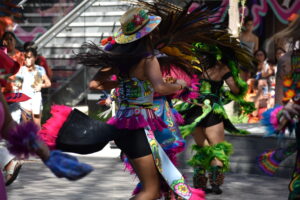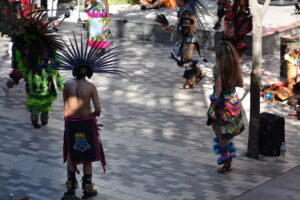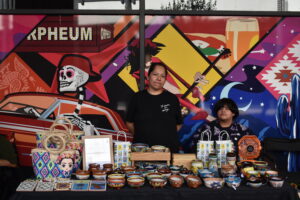- Slug: Indigenous Peoples Day. 1,000 words.
- Photos available (thumbnails, captions below).
By Marshall Baker
Cronkite News
PHOENIX – “Indigenous Peoples Day is a day to embrace all Indigenous people everywhere,” said Deeanna Talley, who goes by Nanibaah. She is the lead singer for Earth Surface People, an Indigenous music collective in Arizona. Her group headlined the mainstage for Indigenous Peoples’ Day Phoenix Fest in downtown Phoenix, a festival celebrating Native culture and artists in and around the Phoenix area.
“For me, I love it. It means so much to me,” Talley said. “It doesn’t limit anyone to a country, to a tribe, whether you’re half Native or mixed. … It’s to embrace every single person from every walk of life, that’s still here as a result of genocide.”
Indigenous Peoples Day has been established in a growing number of communities as a means of celebrating people and culture but also to reclaim Columbus Day.
“In 1492, Columbus sailed the ocean blue” is a poem many people who grew up in the United States learned. The second Monday of October is federally recognized as Columbus Day, a holiday commemorating the arrival of Italian explorer Christopher Columbus into the Americas in 1492.
It was first celebrated as a holiday in 1891, in a time where prejudice against Italian Americans was prevalent. However it is controversial among Indigenous communities across the country because Columbus serves as the symbol of the arrival of European colonization and genocide in North and South America. Columbus also perpetuated harm against the Indigenous people he encountered, enslaving and exploiting inhabitants of the present-day Bahamas.
In 2021, Joe Biden became the first president to issue a proclamation recognizing Indigenous Peoples Day. “For generations, federal policies systematically sought to assimilate and displace Native people and eradicate Native cultures. Today, we recognize Indigenous peoples’ resilience and strength as well as the immeasurable positive impact that they have made on every aspect of American society. We also recommit to supporting a new, brighter future of promise and equity for Tribal Nations,” Biden said in a news release. Biden would issue a separate proclamation for Columbus Day, praising the role of Italian Americans in U.S. history.
As of 2023, approximately 216 cities and 29 states had renamed or replaced Columbus Day with Indigenous Peoples Day, according to RenameColumbusDay.org. Phoenix officially recognized the holiday in 2023, when the City Council voted to designate the second Monday of October as a city holiday.
The Indigenous Peoples’ Day Phoenix Fest was organized by Cahokia PHX, a female-owned, Indigenous-led social tech and artspace focused on empowering Indigenous entrepreneurs and artists in the downtown Phoenix area. It opened a creative space in 2021 and has been holding the festival every year since.
“We got together, and we created the festival in an effort to highlight and amplify the voices and work of many Indigenous creative artists and entrepreneurs,” said Claudia López, co-founder of Local Matriarch and a member of Cahokia PHX. Local Matriarch is focused on empowering Indigenous women and hosted the official launch party for the festival at the Phoenix Art Museum on Friday.
The festival took place at multiple sites around the city, culminating with events at the Arizona Center in downtown Phoenix on Monday. Festivities included:
Arts, crafts and food vendors.
Pop-up shops and art exhibitions.
Live music from local and regional artists.
Skateboarding competitions.
Cultural performances.
1-mile walk and 5K run.
A town hall and art showcase at the Phoenix Indian Center.
“It’s a great effort for us to amplify and put the work of Indigenous creators and entrepreneurs at the forefront,” López said. “The city of Phoenix collaborated with us in making this an official recognized holiday for the city of Phoenix, and we’re very happy to have been able to establish that partnership and that connection with the city.”
For many attendees and participants, Phoenix Fest served as a way of finally feeling visible in spaces that do not usually include them.
Jakob Barlow is a member of the Navajo Nation and hosted a featured pop-up at the festival. He said he felt inspired by the reclamation of the Arizona Center as it filled up with arts and crafts from Indigenous vendors across the country.
“Despite not being something that’s permanent, I’d like us to reclaim the space,” Barlow said. “But at least I feel like we’re here for the day. Hopefully people see what we’re doing out here and start to understand we’re still here. We’re still here to stay, we’re living, not like long and lost, not dead and gone.”
The Phoenix Indian Center is the oldest urban American Indian nonprofit in the country and serves the urban Indigenous community through language and culture revitalization, workforce development programs, suicide prevention and more. The organization is a collaborator with Cahokia PHX in Phoenix Fest and organized the town hall around voting initiatives. It also held its third annual gourd dance and social powwow Saturday as part of its own Indigenous Peoples Day activities.
“I think it just comes back to visibility,” said Levi Long, communications coordinator for Phoenix Indian Center. “What we are doing is basically reclaiming the day for our community. … It is a celebration at the end of the day, but it’s a way for us to connect with our culture and also experience.”
The festival served as a reminder to the Phoenix community that many Indigenous people are alive and thriving, and this event commemorates the past history as well as the future of Indigenous people in this country.
The day gave many the chance to finally feel seen and recognized.
“Something I haven’t experienced most of my life is recognition; that’s why I call myself The Unseen,” Barlow said of his festival pop-up and skateboarding company. “I grew up as an outcast and sort of a loner, and a lot of that comes from being an Indigenous person. Often I meet people where they think we’re gone, and they don’t realize that we’re still around. But today, I feel like I’ve received a lot of validation or recognition just for being present and still expressing. Just living.”
For more stories from Cronkite News, visit cronkitenews.azpbs.org.





